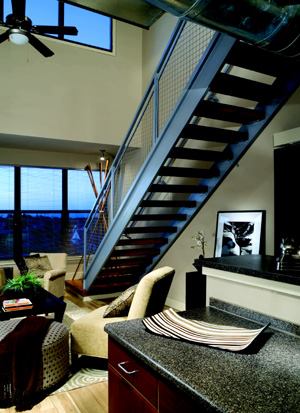Most of The Marquette’s studio units will also have 42-inch-high half-walls between the living room and kitchen, Leipziger says. “Most studios don’t have enough space for a real dining room, and these half-walls can be easily turned into a counter if the residents want to do that,” he adds.
For developers who prefer to keep things free and easy, Campbell suggests using a moveable island in the kitchen. That’s what his firm has recommended for a studio renovation project in suburban Denver. “A moveable island is a great solution—you use it when you need it and move it out of the way when you don’t,” he says. “Even better, you can make it look like a piece of furniture, which can add an upscale feel to the studio.”
SPACE SQUEEZE Islands aside, savvy designers and developers have realized that today’s studio dwellers don’t need much kitchen space, because they end up eating at restaurants or ordering takeout more often than not. They still want all the convenient and necessary appliances like refrigerators and dishwashers but are willing to forgo large ovens, multi-burner ranges, and abundant cabinet space, Harwick says.
“Studio kitchens have become so small that they almost don’t function as normal kitchens,” says Jeff Davis, founder of Raleigh, N.C.-based design firm JDavis Architects. “We’re designing kitchens with two-burner stoves, built-in microwaves, no ovens, and limited cabinet space.”
In fact, by installing few cabinets and smaller appliances, space can be “borrowed” from the kitchen to create walk-in closets and areas for stackable washers and dryers and storage. Campbell points out that the availability of smaller appliances has grown dramatically over the past three years, while the cost premium for smaller appliances has decreased substantially. (For more information on petite appliances, see “Space Savers,” MULTIFAMILY EXECUTIVE, April 2006, page 66.)
SRM Development, for example, now installs dishwashers with 18-inch drawers in its studio units, Rivard notes. The space savings in the kitchen has created enough excess space to add walk-in closets and a full-size washer and dryer in every studio unit, he says.
Similarly, studio units in The Marquette boast two or three closets in addition to a closet that fits a full-size stackable washer and dryer with a hanging rod and shelves, Leipziger says. In fact, many developers and designers are now providing storage areas within their projects. At Austin Ranch, for example, Billingsley provides rentable closets for its residents.
It’s a simple premise, says Leipziger: “You just can’t skimp on storage space.”
Jennifer Popovec is a freelance writer in Fort Worth, Texas.
